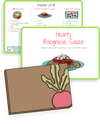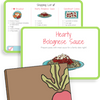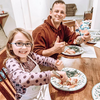As a high school student one of my favorite courses was called River, Valley, Rock, where we studied the history, literature, and science of a unique valley of Western Massachusetts carved out by the Connecticut River. I loved how one subject flowed organically into the other, and the excitement inherent to in-the-field learning.
Learning is done best beyond traditional classroom walls. What I love most about using the kitchen as a classroom is bringing nearly every academic subject to life for kids of all ages. Food can be used across disciplines to empower kids and help them make real world connections. All the while learning to prepare wholesome food – a lifelong skill!

![]() Hang a Map
Hang a Map
Travel the world through food! Hang a map in your kitchen, and locate different countries as you prepare dishes from various cuisines. Even better, mount a large world map on cork board or foam board, and when you make international recipes, use pins to flag the places you've "visited".
![]() Math Tastes Good
Math Tastes Good
The kitchen is filled with real life opportunities to teach practical math. Even before you start cooking, head to the grocery to practice addition, apply coupons, and compare value. Back in the kitchen, young chefs can count and sort ingredients, (“how many green beans are in the bowl?”) While older chefs master estimation, (“is 1 tablespoon bigger or smaller than 2 teaspoons”) fractions (“measure 1 ½ cups flour using the ½ cup measure”) and multiplication (“we need to triple this recipe – how many people will it serve?”).
![]() Kitchen Chemistry
Kitchen Chemistry
Kids of all ages delight in the edible joy of chemistry in the kitchen. Properties change constantly -- whether it’s inedible raw meat sizzling to become a source of energy and sustenance, heavy cream whipping into soft pillows to top berries, or yeast dissolving in warm water, the first step to making quick and easy homemade pizza dough.
We began a recent elementary cooking lesson outside. Here we set up a water basin and gathered a variety of objects – plastic figurines, sponges, wood, cotton socks, etc. A lesson on absorption and weight ensued, and my students were soon sorting and charting objects based on their qualities of absorption. We returned to the kitchen and boiled a cup of water to make Polka Dot Couscous. The students were quick to make a scientific prediction: the dried couscous would absorb water, expand, and weigh more. And of course, it did!
![]() Cultural Connections
Cultural Connections
Using food to discover other cultures might be one of the most authentic approaches to embracing differences. In a unit on Japan, my students discovered that eating miso soup for breakfast was as common as eating cereal in the United States. At first surprised, they soon tried the warm and flavorful broth, and began requesting it to start their day, too! It’s also fun to match music to the food! At home, we use free music websites like Spotify and Pandora to listen to tunes from across the world: from Bocelli while twirling spaghetti, to mariachi on taco night.
![]() The Kitchen Classroom
The Kitchen Classroom
Homeschool families are busy. And while you may plan to teach about the Ancient Inca when preparing quinoa (a superfood vital to that civilization’s strength and power), your best intentions can get pushed aside in an effort to get dinner on the table.
Initially the easiest way to incorporate cooking into your curriculum is to schedule it into your week. Setting aside a Thursday afternoon to make meaningful kitchen connections will motivate your family to get cooking and learning together. Start by cooking recipes that have skills or methods or ingredients relating to a topic your family is studying. Or, choose a favorite family dish to prepare. When you slow down to make it, you’ll discover there are infinite teachable moments at every step!
I love educating my children about where food comes from and how to prepare it. It’s certainly not always neat, but we’ve turned our family kitchen into an exciting classroom. And learning is delicious!
Happy cooking!
Article written by Samantha Barnes, Raddish Founder
The original article was published in the September /October 2014 edition of Homeschool Enrichment Magazine.
Raddish is a cooking club for kids! Created with a mission of bringing families together in the kitchen and at the table, our monthly thematic cooking kits take the guesswork out of cooking with kids while creating delicious kitchen memories along the way. Raddish is designed by a team of educators and chefs who believe the kitchen classroom is the tastiest place to learn. Join our membership today!






